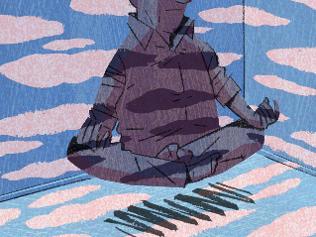Going with the mumbo jumbo
THOSE more bookish types who know English author Tim Parks from the literature shelves will consider this an eccentric excursion.

BROWSERS innocent of Tim Parks's name may well stumble on his latest title in the spirituality or self-help sections of their local bookshop and assume it to be a straightforward account of how one man's embrace of Vipassana meditation helped him overcome a series of painful and seemingly intractable health problems. Those more bookish types who know the English author from the literature shelves will consider it an eccentric excursion, a book apart from Parks's oeuvre.
None of these readers will be quite correct. Teach Us to Sit Still is too literary, too idiosyncratic and too ambivalent about its stated quest to fit with the folksy uplift and prescriptiveness of the sub-genre known as "lifestyle enhancement".
Instead we get a lucid philosophical interrogation of the mind-body problem, informed by Parks's own recent experience and those of earlier writers whose physical sufferings similarly shaped their work.
Yet this really is, as the book's subtitle has it, "a sceptic's search for health and healing". Parks does describe a physical crisis in these pages, furnishing readers with a thorough and forthright case study in chronic pain whose growing intensity demanded radical alternatives to Western medical common sense and British stiff upper lip.
Moreover, the literary impulses that drove his busy and illustrious career as a translator, essayist and novelist turn out to be part of the problem. As Parks explains:
The first, literary self doesn't do much to help the second, the sufferer. The literary self likes finding forms and words to talk about things metaphorically, to make them more dramatic and intriguing than they are. He thinks of this as art and congratulates himself when someone pays him for what he does. Meantime the sufferer tries to ignore his pains. The two selves don't connect.
This, then, is the story of a growing disconnection between Parks the writer and Parks the middle-aged man, and his efforts to bind them together. The result is a book at once wise and weird: wise because it traces a deepening in the author's knowledge of self; and weird since this getting of wisdom involves a dismantling of that self and a distrust of the language that gives form to the accumulated experience from which such selves are made. Teach Us to Sit Still is a successful work of literature about the ways literature fails and misrepresents us.
As if to highlight the split between mental and physical realms, Park's body betrays him in those regions farthest from the noble seat of the intellect: the pelvis. It is there that an unidentifiable yet intense pain blooms, soon to be joined by a leaky bladder that requires up to a half-dozen bathroom trips each night.
Amid the discomfort, sleeplessness and incipient impotence caused by these symptoms, Parks follows the best medical advice he can get; that is, to do something about his prostate. But before he undergoes a gruesome-sounding laser suturing procedure, a test reveals his prostate is healthy. The problem, it seems, lies elsewhere. Throughout numerous "purgatorial dawns", Parks trawls the web, searching for fellow sufferers of phantom pelvic pain. And from these researches he gleans the existence of a condition caused by muscular tension in that area of the body. Having purchased online A Headache in the Pelvis, a book by US specialists that recommends breathing exercises to relax those muscles, Parks overcomes his "intense distrust of any treatment not underwritten by Western science" long enough to find that he can banish, albeit briefly, his abdominal pain.
Parks exults in the lesson of these basic breathing exercises. He now knows that he can remove the hurt without drugs. The next step is full-blown meditation. And while his experience of Vipassana meditation turns out to be the almost-total cure for his physical ailments, it paradoxically creates the strongest tensions in the narrative so far.
The problem is tied up with the author's upbringing. Parks was the child of an Anglican minister and devout wife who drifted into the charismatic wing of the church when their son was in his teens. His rejection of their religious beliefs was replaced by faith in the non-nonsense English empiricism from which modern science is built. As he sits in a converted Italian nunnery, listening to the practised mumbo jumbo of a lecherous and overweight American meditation guru who asserts that "Vipassana means seeing things as they really are" and claims it to be "the process of self-purification by self-observation . . . a universal remedy for universal problems", Parks cleaves to his old self:
"Universal" and "remedy", I thought, are two words that when put together can only epitomise wishful thinking, unless we are talking about a bullet in the brain. Purification, on the other hand, was a concept I couldn't begin to understand and hence a goal I could hardly desire. As for seeing things as they are, I knew that meditation was done with the eyes closed.
It is this humour and scepticism that keeps Teach Us to Sit Still in some kind of balance and gives the rest of us a means of approaching what is an often-moving, life-altering experience. He may achieve that "noble silence" that is the culmination of a long and difficult practice of meditation, but Parks's restless intellect and singing prose never cease their sparring with the ineffable.
Geordie Williamson is The Australian's chief literary critic.



